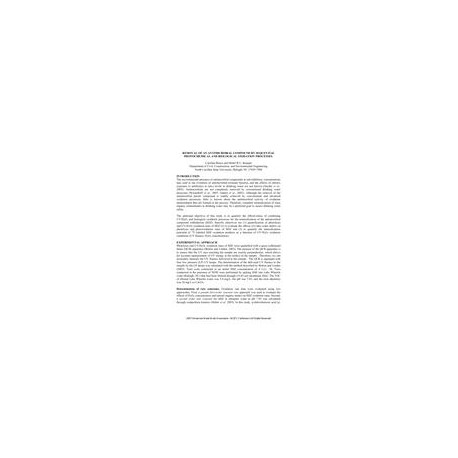Cart
0
Product
Products
(empty)
No products
To be determined
Shipping
$0.00
Total
Product successfully added to your shopping cart
Quantity
Total
There are 0 items in your cart.
There is 1 item in your cart.
Total products
Total shipping
To be determined
Total
New
Reduced price!
 View larger
View larger
 View larger
View larger
AWWA WQTC65770
M00053176
New product
AWWA WQTC65770 Removal of an Antimicrobial Compound by Sequential Photochemical and Biological Oxidation Processes
Conference Proceeding by American Water Works Association, 11/01/2007
Baeza, Carolina; Knappe, Detlef R.U.
Full Description
The principal objective of this study was to quantify the effectiveness of combiningUV/Hsub2/subOsub2/sub and biological oxidation processes for the mineralization of the antimicrobialcompound sulfadiazine (SDZ). Specific objectives included: quantification of photolysisand UV/Hsub2/subOsub2/sub oxidation rates of SDZ; evaluate the effects of a lake water matrix onphotolysis and photooxidation rates of SDZ; and, quantify the mineralizationpotential of 14C-labeled SDZ oxidation products as a function of UV/Hsub2/subOsub2/sub oxidationconditions (UV fluence, Hsub2/subOsub2/sub concentration).Photolysis and UV/Hsub2/subOsub2/sub oxidation rates of SDZ were quantified with a quasi-collimatedbeam (QCB) apparatus (Bolton and Linden, 2003). The purpose of the QCB apparatus isto ensure that the UV rays reaching the sample are exactly perpendicular, which allowsfor accurate measurement of UV energy at the surface of the sample. Therefore, we canaccurately measure the UV fluence delivered to the sample. The QCB is equipped withfour low pressure (LP) UV lamps. The determination of the delivered UV fluence to thesample by the LP lamps was calculated with the method described by Bolton and Linden(2003). Tests were conducted at an initial SDZ concentration of 4 (1) M. Testsconducted in the presence of natural organic matter (NOM) were performed by spiking SDZ into Lake Wheelerwater (Raleigh, NC) that had been filtered through a 0.45-m membrane filter. The TOCof filtered Lake Wheeler water was 5.0 mg/L, the pH was 7.85, and the total alkalinitywas 24 mg/L as CaCOsub3/sub. Includes 8 references, tables, figures.In stock

